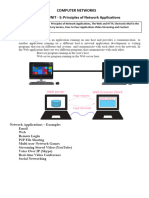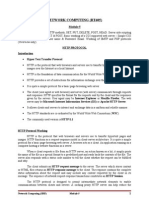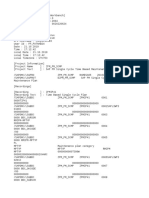Introduction To HTTP - Understanding HTTP Basics
Uploaded by
Ga ToneIntroduction To HTTP - Understanding HTTP Basics
Uploaded by
Ga ToneHome MQTT MQTT Python MQTT Brokers IOT APIs Node-Red
Updated:July 17, 2020 ⁄ By steve Polls
Understanding HTTP Basics Do you Use LoRaWan?
HTTP stands for hypertext transfer protocol and is used to transfer data across the Yes
Web. No
It is a critical protocol for web developers to understand and because of it widespread use it is also used in Vote
transferring data and commands in IOT applications.
View Results
The first version of the protocol had only one method, namely GET, which would request a page from a
server.
Google Ads
The response from the server was always an HTML page.- Wiki
To give you an idea of how simple the HTTP protocol started out take a look at the Original specification
which was only 1 page.
There have been several versions of HTTP starting with the original 0.9 version.
The current version is 1.1 and was last revised in 2014. See Wiki for more details.
How It Works
Like most of the Internet protocols http it is a command and response text based protocol using a client Search
server communications model.
Search …
Subscribe to Newsletter
Name*
Email*
Subscribe
The client makes a request and the server responds.
Hi - I'm Steve and welcome
to my website where you
The HTTP protocol is also a stateless protocol meaning that the server isn’t required to store session
can learn how to build IOT
information, and each request is independent of the other.- See this wiki
systems using Node-Red
and MQTT. If you like to support this site
This means:
then you should consider making a
contribution.
All requests originate at the client ( your browser)
The server responds to a request.
The requests(commands) and responses are in readable text.
The requests are independent of each other and the server doesn’t need to track the requests.
Request and Response Structure
Request and response message structures are the same and shown below:
A request consists of:
A command or request + optional headers + optional body content.
A response consists of: About Me
MQTT Tools
A status code + optional headers + optional body content. MQTT Quizzes
Ask Steve – Need Help -Hire Me
A simple CRLF (carriage return and Line feed) combination is used to delimit the parts, and a single blank Networking
line (CRLF ) indicates end of the headers.
My Youtube Channel
If the request or response contains a message body then this is indicated in the header.
The presence of a message body in a request is signalled by a Content-Length or Transfer-Encoding header field.
Request message framing is independent of method semantics, even if the method does not define any use for a
node-red
message body. – RFC 7230 section 3.3.
MQTT Brokers
mqtt and python
Note: the message body is not followed by a CRLF See RFC 7230 section 3.5
Internet
HTTP Requests
We saw the general request response format earlier now we will cover the request message in more detail.
The start line is mandatory and is structured as follows:
Method + Resource Path + protocol version
Example if we try to access the web page testpage.htm on www.testsite5.com
The the start line of the request would be
GET /test.htm HTTP/1.1
Where
GET is the method
/testpage.htm is the relative path to the resource.
HTTP/1.1 is the protocol version we are using
Notes:
1. A relative path doesn’t include the domain name.
2. The web browser uses the URL that we enter to create the relative URI of the resource.
Note: URL (uniform resource Locator) is used for web pages. It is an example of a URI (uniform resource
indicator).
The actual http request is not shown by the browser, and is only visible using special tools like http
header live (Firefox).
HTTP vs URL
Most people are familiar with entering a url into a web browser. Usually looking like this.
The url can also includes the port which is normally hidden by the browser, but you can manually include
it as shown below:
This tells the web browser the address of the resource to locate and the protocol to use to retrieve that
resource (http).
http is the transfer protocol that transfer the resource (web page,image,video etc) from the server to the
client.
HTTP Responses and Response Codes
Each request has a response. The Response consists of a
STATUS code And Description
1 or more optional headers
Optional Body message can be many lines including binary data
Response Status codes are split into 5 groups each group has a meaning and a three digit code.
1xx – Informational
2xx – Successful
3xx -Multiple Choice
4xx– Client Error
5xx -Server Error
For example a successful page request will return a 200 response code and an unsuccessful a 400
response code.
You can find a complete list and their meaning here
Request Response Example
We are going to examine he requests and response when we access a simple web page (testpage.htm)
Here is what I enter in the browser address bar:
and this is the response that the browser displays:
and here is a screen shot of the http request-response that happens behind the scenes.
Notice the request headers are automatically inserted by the browser, and so are the response headers
are inserted by the web server.
There is no body content in the request. The body content in the reply is a web page, and is shown in the
browser, and not by the live headers tool.
Request Types
So far we haven’t mentioned request types, but we have seen the GET request type in our examples.
The GET request type or method is used for requesting a resource from a web server.
GET is most commonly used request type and was the only request type in the Original HTTP specification.
Request Types, Methods or Verbs
The HTTP protocol now support 8 request types, also called methods or verbs in the documentation,they
are:
GET – Requesting resource from server
POST – submitting a resource to a server (e.g. file uploads)
PUT -As POST but replaces a resource
DELETE-Delete a resource from a server
HEAD – As GET but only return headers and not content
OPTIONS -Get the options for the resource
PATCH -Apply modifications to a resource
TRACE -Performs message loop-back
On the Internet today the GET (getting web pages) and POST (submitting web forms)methods are the
ones most commonly used.
The Other methods are used when working with Web and IOT APIs specifically put,delete and head.
There is a good basic overview on w3 schools, and the Microsoft MDN site covers them in more detail.
Part 2 HTTP headers
Related Tutorials and Resources
The TCP/IP protocol suite for beginners
Using Curl for Testing IOT Applications
Please rate? And use Comments to let me know more
7 comments
Pirulino says:
April 30, 2020 at 5:43 pm
Thanks, it was very helpful.
Reply
Vikas says:
February 17, 2020 at 3:44 pm
What headers are compulsory to add when sending a request? I know HOST: and CONNECTION: has to be added,
question is what if I don’t add USER-AGENT etc?
Reply
steve says:
February 17, 2020 at 5:41 pm
Hi
I believe Host is the only required header.If you don’t supply the headers required by the application then you
may not get the desired response.
Reply
Akhil says:
August 25, 2019 at 6:26 pm
Thanks for the information. What does CRLF stand for? And what does it mean?
Looking forward to Part 2 HTTP headers.
Reply
steve says:
August 26, 2019 at 10:08 am
Carriage return and Line Feed.
Reply
Waleed says:
August 7, 2019 at 5:06 am
Why is HTTP version number presented in both a request line and a statue line
Reply
steve says:
August 7, 2019 at 3:09 pm
It is in the request and response and indicates the version used by the browser and the version supported by
the server.
Reply
Leave a Reply
Your email address will not be published. Required fields are marked *
Comment
Name *
Email *
Website
Post Comment
Sign Up to Newsletter
Sitemap |About & Contact | Privacy Policy
Copyright © 2011-2021 Steve's internet Guide
By Steve Cope
You might also like
- Hourglass Workout Program by Luisagiuliet 276% (21)Hourglass Workout Program by Luisagiuliet 251 pages
- Read People Like A Book by Patrick King-Edited57% (82)Read People Like A Book by Patrick King-Edited12 pages
- Livingood, Blake - Livingood Daily Your 21-Day Guide To Experience Real Health77% (13)Livingood, Blake - Livingood Daily Your 21-Day Guide To Experience Real Health260 pages
- Donald Trump & Jeffrey Epstein Rape Lawsuit and Affidavits83% (1016)Donald Trump & Jeffrey Epstein Rape Lawsuit and Affidavits13 pages
- The 36 Questions That Lead To Love - The New York Times94% (34)The 36 Questions That Lead To Love - The New York Times3 pages
- The 36 Questions That Lead To Love - The New York Times95% (21)The 36 Questions That Lead To Love - The New York Times3 pages
- Jeffrey Epstein39s Little Black Book Unredacted PDF75% (12)Jeffrey Epstein39s Little Black Book Unredacted PDF95 pages
- 14 Easiest & Hardest Muscles To Build (Ranked With Solutions)100% (8)14 Easiest & Hardest Muscles To Build (Ranked With Solutions)27 pages
- The 4 Hour Workweek, Expanded and Updated by Timothy Ferriss - Excerpt23% (954)The 4 Hour Workweek, Expanded and Updated by Timothy Ferriss - Excerpt38 pages
- Hypertext Transfer Protocol (HTTP) : Gurjot Singh Revti Raman Singh Ug201113013 Ug201110026No ratings yetHypertext Transfer Protocol (HTTP) : Gurjot Singh Revti Raman Singh Ug201113013 Ug20111002619 pages
- Cs8651 Internet Programming Unit I Website Basics, HTML 5, Css 3, Web 2.0 9No ratings yetCs8651 Internet Programming Unit I Website Basics, HTML 5, Css 3, Web 2.0 937 pages
- Interaction Between Client and Server: INF 335 Web Server TechnologiesNo ratings yetInteraction Between Client and Server: INF 335 Web Server Technologies43 pages
- EContent 11 2023 03 01 18 07 21 02Unit2ApplicationLayerpptx 2023 01 31 08 52 45No ratings yetEContent 11 2023 03 01 18 07 21 02Unit2ApplicationLayerpptx 2023 01 31 08 52 4583 pages
- Network Computing (Rt605) : Hyper Text Transfer ProtocolNo ratings yetNetwork Computing (Rt605) : Hyper Text Transfer Protocol19 pages
- Cs8651 Internet Programming Unit I Website Basics, HTML 5, Css 3, Web 2.0 9No ratings yetCs8651 Internet Programming Unit I Website Basics, HTML 5, Css 3, Web 2.0 937 pages
- Advanced Implementation of IoT Systems: Leveraging MQTT and Node-RED for Real-Time Data ManagementFrom EverandAdvanced Implementation of IoT Systems: Leveraging MQTT and Node-RED for Real-Time Data ManagementNo ratings yet
- Siemens Simatic S 7 300 - 400 - From S5 To S794% (18)Siemens Simatic S 7 300 - 400 - From S5 To S7154 pages
- How To Configure High Availability On PAN-OS Palo Alto Networks LiveNo ratings yetHow To Configure High Availability On PAN-OS Palo Alto Networks Live12 pages
- Debugging With GDB: Richard Stallman, Roland Pesch, Stan Shebs, Et AlNo ratings yetDebugging With GDB: Richard Stallman, Roland Pesch, Stan Shebs, Et Al589 pages
- Core React: State of A Component Is An Object That Holds Some Information ThatNo ratings yetCore React: State of A Component Is An Object That Holds Some Information That29 pages
- CCIE Enterprise Infrastructure Lab v1.0 - Practice Lab - TopologyNo ratings yetCCIE Enterprise Infrastructure Lab v1.0 - Practice Lab - Topology11 pages
- How Do You Implement MODBUS Communication With S7-200No ratings yetHow Do You Implement MODBUS Communication With S7-2005 pages
- Remoteshellserver Commandrunner: Javabuild - Bat Remoteshell - Jar Remoteshell - JarNo ratings yetRemoteshellserver Commandrunner: Javabuild - Bat Remoteshell - Jar Remoteshell - Jar3 pages
- Io-Link To Ethernet/Ip and Modbus TCP Gateway: User ManualNo ratings yetIo-Link To Ethernet/Ip and Modbus TCP Gateway: User Manual94 pages























































































































